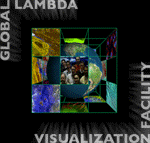GLVF: OptIPuter and Global Lambda Visualization Facility

Website
http://www.evl.uic.edu/cavern/glvf/Collaborators
Canada: Simon Fraser University; University of Alberta; CANARIEJapan: Kyoto University, Academic Center for Computing and Media Studies; National Institute of Advanced Industrial Science and Technology, Grid Technology Research Center
The Netherlands: SARA Computing and Networking Services; NetherLight; SURFnet
South Korea: Gwangju Institute of Science & Technology (GIST); Korea Institute of Science & Technology Information (KISTI); KRLight
United States: University of Illinois at Chicago, Electronic Visualization Laboratory; StarLight; University of California San Diego (UCSD) Calit2; UCSD National Center for Microscopy Imaging Research; UCSD Scripps Institution of Oceanography; University of Illinois, National Center for Supercomputing Applications (NCSA); NCSA-TRECC; NCSA-ACCESS; Purdue University, Envision Center; University of Michigan, Collaboratory for Research on Electronic Work; Geological Survey (USGS), Earth Resources Observation Systems (EROS);
Description
The Global Lambda Visualization Facility (GLVF), established in September 2005, addresses the need to integrate visualization and collaboration technologies with global cyberinfrastructure. GLVF leverages networking infrastructure amassed as part of the Global Lambda Integrated Facility (GLIF). EVL is a founding member of GLIF. TransLight/StarLight is a GLIF resource and StarLight is a model for GLIF Open Lightpath Exchanges (GOLEs).
Having worked with OptIPuter/GLVF participants to prototype a global collaborative visualization environment for iGrid 2005, the KISTI Supercomputing Center wanted to demonstrate the benefits to Korea’s Ministry of Science and Technology and to KISTI scientists in February 2006. KISTI, an OptIPuter partner, used its 100-megapixel SAGE-enabled tiled display to show 5-6 high-definition streams sent simultaneously from partner sites in the US, Canada and the Netherlands. KISTI received an average of 3Gbps of information for several hours.

